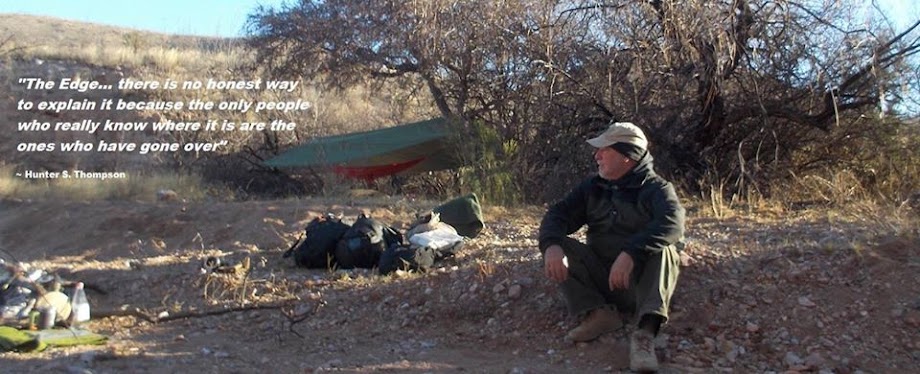I was lying on my bamboo bed in the cool of the early morning jungle dawn. I had wrapped myself in a damp bed sheet that I was using as a blanket, and using my pack as a pillow. The uncomfortable humidity and my wet clothing were all combining to make a comfy sleep impossible.
It had been raining all night, and I was, shivering in my damp clothes and blanket.
I’m not sure of the time, but it was barely light when I saw my good friend Tata Kasoy enter the hut and make a "pire"(fire) for "Kopi"(coffee) and to cook a few bananas for breakfast.
The previous morning My Adventure buddy Jungle Wil and I had met our Good friends Miguel and Tata at the trail head near Pamulaklakin, after exchanging gifts and sharing a meal of coffee, sardines and rice cooked in bamboo, I realized that I had forgotten my Bolo knife in Cebu so I traded my mini mag flash light and 6 batteries to the lead forest ranger for an extra bolo of his, it is a cool looking knife and the sheath is made from PVC plastic heated and cut to shape then held together with screws.
It is a cool looking knife and a good trade. I tied it on my belt , and we hit the trail.
We hiked for several hours deep into the Aeta territory; we entered the territory of Antonio the younger brother of Tata . I had no idea we had entered his land but suddenly Tata spied a faint trail leading off to the right and said "dis trail my broder" we followed it for a long while then tata began to shout in Aeta to his brother that we were in his territory.
After a search of about 10 minutes we managed to locate Antonio, he just materialized from the trees wearing black clothing and sporting the longest bolo relative to his size I had ever seen. We were invited to his Jungle camp for More "Kopi" and BBQd bananas.
Antonio’s camp consisted of a hut made of a bamboo frame covered by plastic and was basically 2 platforms with a star fire in the center. I like it and felt comfortable there and would have enjoyed sleeping there for the evening if Tata and Miguel had not made other plans.
After swapping news with Antonio and having a bit to eat we packed up and headed out, due to the amount of rain over the past few days it was important to head up the trail and make a river crossing before it was too strong to do so. Our Aeta friends said "big water come"(heavy rain) several times so heeding their advice, we shouldered our packs moved out at a fast pace up the trail.
The small stature of our Aeta friends belies their speed and agility in the forest, both Jungle wil and I keep in shape with regular running and mountain biking, but on the jungle trail we had a difficult time keeping up with our guides. They walk fast but do not miss a single thing like useful plants, animal tracks, or signs of non Aeta in the forest. There is a major problem with Illegal Logging on Aeta lands and these guys mount regular patrols into the jungle to protect their property.
We seemed to climb and climb as we headed deeper into the jungle I cannot recall a single level trail, it was difficult going due to the mud and heavy rain, upon reaching the river we made the crossing without problems but it was evident that the water strength was building and it would soon be impossible to cross.
After a hike of several more hours we reached an area of the Aeta territory that was pretty far back in the woods, it was only about 4 pm but it was nearly dark under the jungle canopy. We set about constructing a jungle shelter and covered it with some blue tarps we had brought along.
Tata Kasoy and Miguel strung their Duyen (Hammocks as we call them) and set up their rain tarps made from grain sacks sewn together. It was great to see the clever use of available materials and it is interesting to note that Miguel and Tata always wear the Head lamps we gave them even when it is not dark. I asked them about this practice and was told it is so they are always ready.
It is a good thing they had the head lamps because by the time we made camp, built a fire and settled in for the evening it was full dark even though it was only about 5 pm. We had a good evening, chatting and singing(oldies and filipino songs) away the hours, dining on corned beef, boiled bananas, bamboo rice, "kopi" and Emperador brandy.
Jungle Wil and I had brought along a spice kit that contained tobasco, rock salt, garlic, and sugar. It was a big his as well as the Hands of tobacco we brought along, Miguel rolled cigarettes and smoked away the hours while Tata liked to chew. I chewed a bit of tobacco myself while sipping brandy.
It was an excellent to be back in the forest again with my 3 friends enjoying their company. We were drinking and singing while sitting around a small circle of light in a remote forest; it is a scene that has been played out a billion or more times throughout the history of mankind Im sure.
Being there at that time in that location with my 3 good friends is a memory I will always cherish and I am looking forward to being able to return to the jungle for more adventures.
See you on the trail!
Tomahawk - Scout out!



.jpg)
.jpg)
.jpg)
.jpg)
.jpg)








